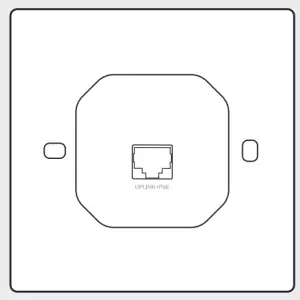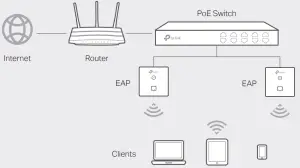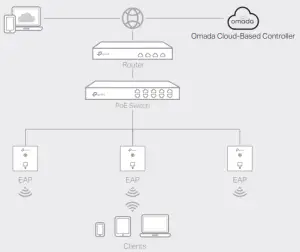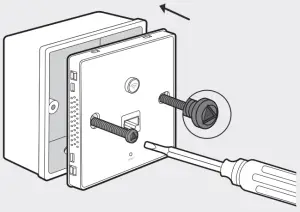tp-link Wireless Wall Plate Access Point Installation Guide
Setup with videos
Scan QR code or visit
 https://www.tp-link.com/support/setup-video/
https://www.tp-link.com/support/setup-video/
Note: The image may differ from the actual product.
Hardware Overview
Front Panel

LED/Wi-Fi Button
When the EAP is working in Standalone Mode and enabled with Wi-Fi Control, press the button to turn on/off both the Wi-Fi and LED. In the other cases, press the button to turn on/off the LED only
LAN Port
A wired device can be connected to the LAN port via an Ethernet cable and access the network.
RESET
With the EAP powered on, press and hold the button for about 5 seconds until the LED flashes, then release the button. The EAP will restore to factory default settings.
LED Indicator
On: Working normally/Initializing.Off: Working abnormally/Power off/LED is turned off.
Flashing:
- Initialization: The LED flashes twice after initialization is completed.
- Upgrade: The LED flashes once per second while upgrading.
- Reset: The LED flashes quickly during the reset. The EAP will then reboot.
- Locate: When the Locate feature is activated in the Omada controller, the LED flashes quickly to locate and identify the device. The LED will flash for 10 minutes, or you can disable the feature manually to stop it flashing.
Rear Panel

UPLINK+PoE Port
Connected to a PSE (Power Sourcing Equipment), such as a PoE switch, for both data transmission and Power.
Pre-Installation Checklist
Before installation, be sure that you have the following items:
- A pre-installed wall junction box
- An RJ45 plug
- A triangular screwdriver
- A Phillips screwdriver
- A PoE switch
Installation Steps
The EAP can be mounted into either an 86 mm wall junction box or a standard EU wall junction box. The junction box should be pre-installed with a running-in-wall Ethernet cable connected to a PoE switch.

- Detach the faceplate of the junction box with a Phillips screwdriver (demonstrated with an 86 mm wall junction box).

- Detach the faceplate of the EAP with a screwdriver.

- Connect the Ethernet cable inside the junction box to an RJ45 plug. Then connect the cable to the UPLINK+PoE port. Position the Ethernet cable to ensure it is not strained.

- Insert the enclosed screws and tighten them with a triangular screwdriver to secure the mounting bracket.
 Note:
Note:
- Do not over tighten the screws.
- If the enclosed screws do not fit the junction box, use the screws attached to the junction box instead.
- Press the faceplate of the EAP back into position.

Software Configuration
A DHCP server (typically a router with DHCP function enabled) is required to assign IP addresses to the EAPs and clients in your local network.
The EAP supports two configuring options:
- To configure and manage EAPs singly (usually suitable for a small network with a few EAPs), Standalone Mode is recommended. Please refer to Option 1.
- To configure and manage EAPs in batch, Controller Mode is recommended. Please refer to Option 2.
Option1: Standalone Mode

Via Omada App
- Download the TP-Link Omada App on your mobile device. It can be downloaded from App Store or Google Play:











- Connect your mobile device to the EAP by using the default SSID (format: TP-Link_2.4GHz/5GHz_XXXXXX) printed on the label at the bottom of the product.
- Open the Omada App, and wait for the EAP to appear on the Standalone APs page. Tap on the EAP you want to configure.
The Omada App is designed to help you quickly configure the common settings. If you want to configure advanced settings, log in to the web page of your EAP or the controller.
Via a Web Browser
- Connect wirelessly by using the default SSID (format: TP-Link_2.4GHz/5GHz_XXXXXX) printed on the label at the bottom of the product.
- Launch a web browser and enter http://tplinkeap.net in the address bar. Use admin for both Username and Password to log in.
- Set up a new Username and Password for secure management purpose. Modify the wireless parameters and reconnect your wireless devices to the new wireless network.
To configure other EAPs, connect your device to the EAP by the corresponding default SSID and repeat the steps listed above. You can configure some basic functions in Standalone Mode. If you want to configure advanced functions, use Controller Mode.
Option2: Controller Mode
Controller Mode applies to the large scale network with mass devices. All devices can be centrally configured and monitored via Omada Software Controller, Omada Hardware Controller or Omada Cloud-Based Controller.


Via Omada Software Controller
- On the PC with Windows OS or Linux OS, download the Omada Software Controller installation file fromhttps://www.tp-link.com/support/download/omada-software controller/.
- Run the file and follow the wizard to install the Omada Software Controller.
- Launch the Omada Software Controller and follow the step-by step instructions to complete the Quick Setup. After the wizard is finished, a login screen will appear.
- Enter the username and password you created and click Log in. Then you can further configure the network.
Omada Cloud Portal
After installing Omada Software Controller, you can remotely access the controller through Omada Cloud Portal. Follow the steps below
- Enable Cloud Access on the setting page on the controller and bind a TP-Link ID to your controller. If you have configured this in the setup wizard, skip the step.
- Launch a web browser and enter https://omada.tplinkcloud.com in the address bar.
- Enter your TP-Link ID and password to log in. A list of controllers that have been bound with your TP-Link ID will appear. Then you can click Launch to further configure the controller.
Omada App
With Omada App, you can also manage your Omada Software Controller at a local site and remote site. Note that Omada Software Controller needs to be kept running when using Omada App.
- Download the TP-Link Omada App on your mobile device. It can be downloaded from App Store or Google Play.














- Launch your Omada App and configure the controller at a local site or remote site.
- Local Management
- a. Connect your mobile device to the EAP by using the default SSID (format: TP-Link_2.4GHz/5GHz_XXXXXX) printed on the label at the bottom of the product.
- b. Launch Omada App and go to Local Access, tap the + button on the upper-right corner to add the controller. Then you can further configure the controller.
- Remote Management
- a. Make sure Cloud Access is enabled on your controller and your controller has been bound with your TP-Link ID.
- b. Launch Omada App and log in with your TP-Link ID. Then go to Cloud Access. A list of controllers that have been bound with your TP-Link ID will appear. Then you can further configure the controller.
Via Omada Hardware Controller (OC200/OC300)
Omada Hardware Controller (OC200/OC300), which is pre-installed with Omada Software Controller, is a good alternative if you have no spare PC to keep running Omada Software Controller in the network. It needs to be purchased additionally. For more details, refer to the Installation Guide of OC200/OC300.


Via Omada Cloud-Based Controller
Before managing the devices via Omada Cloud-Based Controller, make sure they can access the internet.
- Launch a web browser and enter https://omada.tplinkcloud.com in the address bar. Enter your TP-Link ID and password to log in.
- Click Add Controller and register for an Omada Cloud-Based Controller. Follow the instructions to complete the setup process.
- Add devices with the serial number, make sure the devices are online and in factory default.
- Assign appropriate licenses in order to manage and configure the devices on the cloud-based controller. Then wait until your controller is deployed.
Omada App
With Omada App, you can also manage your Omada Cloud-Based Controller.
- Download the TP-Link Omada App on your mobile device. It can be downloaded from App Store or Google Play:














- Launch Omada App and log in with your TP-Link ID. Then go to Cloud Access. A list of controllers that have been bound with your TP-Link ID will appear. Then you can further configure the controller.
For the detailed configurations, refer to the User Guide of the controller and EAPs. The guides can be found on the download center of our official website: https://www.tp link.com/support/download/.
- To ask questions, find answers, and communicate with TP-Link users or engineers, please visit https://community.tp-link.com to join TP-Link Community
- For technical support, the user guide and other information, please visit https://www.tp-link.com/support, or simply scan the QR code.


- If you have any suggestions or needs on the product guides, welcome to email [email protected].


Safety Information
- Keep the device away from water, fire, humidity or hot environments.
- Do not attempt to disassemble, repair, or modify the device. If you need service, please contact us.
- Do not use the device where wireless devices are not allowed.
References
Download Center | TP-Link
TP-Link Community
TP-Link Product Support – Wireless Networking Equipment Support
Omada Cloud
域名售卖
Support Videos | TP-Link
Download for Omada Software Controller | TP-Link
GPL Code Center | TP-Link
Download Center | TP-Link
域名售卖
Download for Omada Software Controller | TP-Link
Omada Cloud
TP-Link Product Support – Wireless Networking Equipment Support
Support Videos | TP-Link
TP-Link Community
域名售卖
Omada Cloud
Support Videos | TP-Link
Download Center | TP-Link
Download for Omada Software Controller | TP-Link
TP-Link Community
TP-Link Product Support – Wireless Networking Equipment Support
域名售卖
TP-Link Product Support – Wireless Networking Equipment Support
TP-Link Community
Omada Cloud
Download for Omada Software Controller | TP-Link
Support Videos | TP-Link
[xyz-ips snippet=”download-snippet”]




 Note:
Note:
